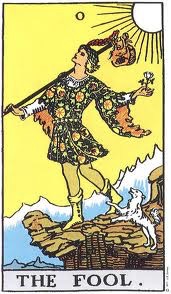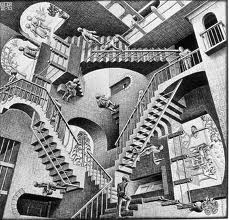The Folly We Pursue

We’ll stand before the folly of power before falling to our knees and praying for the humility that power never brings.
We’ll wash our feet in the fountain of wealth to remind ourselves to see the necessity of charity and the futility of greed.
I’ll borrow the shoes those other guys wear and stumble along their trail while they try on my sneakers once to hike my humbled mile.
We’ll feast on food that’s “bad for you” and live to tell the tale to remind ourselves how little we know, what our studies never tell.
We’ll snub the neighbors we usually greet and greet the ones we snub to better see the community we’d inadvertently scrubbed.
We’ll unplug all the media and shut down every shop to remind ourselves what might be real before this hamster wheel stops.
We’ll park our cars on the freeways and hike all the way to work and approach every serious assignment with a healthy, skeptical smirk.
We’ll revel in revelation and embrace inconvenient truth to distinguish between our wisdom and the ignorance of youth.
All will pass and none will fail; each will be rewarded with the experience of a small salvation and see the folly of damnation.
And this damned nation might survive another millennium or two if we could, each year, acknowledge half the folly we pursue.
©2011 by David A. Schmaltz - all rights reserved
Set Theory
While fans and audiences think in terms of songs, performers parse their experience differently—into sets. A set might be most readily understood as a collection of songs, but it’s much, much more than that. Properly devised, a set works like a story, linking individual songs into an indivisible whole. Like within a song, where verse builds to chorus, chorus to bridge, bridge to close, a set develops a plot line using individual melodies.
The maturation of a songwriter begins with the shatteringly intermittent ability to pull songs out of the ether. Whether one chooses (or is chosen) to pull the lyrics before or after the melody, the sequence of creation never really matters. Ultimately, it’s a push-me/pull-you affair. I’m still fine-tuning songs I clocked as finished decades ago.
But finishing a song doesn’t leave anyone even halfway done. What does one do with a finished song? I store ‘em as lyric sheets in the bottom of my guitar case until called to perform. “David, you will be playing a few songs for our dinner guests, won’t you?”
Well, sure I will. But there are deeper questions. What tunes fit this situation? In what order should I choose to play them? How might I relate these songs to the conversations we held over supper? To what purpose will I perform?
These are set questions. I will select from the thin catalogue of songs I’m currently practiced up on. From these half-dozen, I’ll sort for the right one to start and the proper one to end with. I will buck up my introversion into floating eye contact and hope for the best. However well-practiced the guitar playing and the singing, I’ll judge myself more on the quality of the encapsulation: the introducing story, the threads between songs, and the bigness of the finish. And in that after supper half hour, I will perform a cobbled-together set of songs.
I’ve been performing like this for most of my life and I still hold deep questions and even deeper misgivings about my skill. I know I’m no musician. Sure, I play my guitar and sing my own songs, but I accomplish this without virtuosity. I have no complete idea what the real chord names are, and communicate these to myself in my own curious language. I do not play the chords properly, either. I seem incapable of fluently reading notation, and have failed innumerable times to correctly transcribe. Music theory remains abstract theory and not my practice.
I might be more intuition than musician. Music seems an extension of my native intuition, of which I have an abundance. It’s a form of expression like speaking or writing. I’m no grammarian, either, but rely upon my nose, my developing sense of proper structure, rather than a remembered rule set.
Still, I have written songs which have remained more or less stabile over long years, and can recreate them pretty much at will. I have no similar intuition about sets. I remain blind to the possibilities, like choosing marbles out of an opaque bag, when I set about creating a set of songs.
The notion eventually emerges: what would my set sound like? Where would I begin? Where would I end? And what path would I choose to get there if I was really choosing? Now that the songs are written, how should I string them together and to what larger-than-individual-tune purpose?
When I was twenty five, I decided to get out of the music business, go to university, and get a real job. Of course, every piece of this chosen different path smugly mirrored the business I said I was leaving behind. I didn’t write as many melodies but drew from the same intuition to compose project plans. My life in the business world involved playing a different shaped guitar. Other than that inconsequential distinction, it was the same.
Later, as a consultant, I found myself writing songs again, this time in the guise of models. These, I’d string into reasonable sequences and perform as workshops. Even later, I started writing about my experiences and found that same progression. I’d write the vignette then string it together with other ones to make a coherent story.
Only in my background music world, it seems, have I somehow managed to stiff-arm stringing together my work into coherent sets. And it’s now past time. I feel moved now to attempt this meta creation. To take that pile of lyrics mouldering in the bottom of my guitar case and pull them together into an indivisible story. I should not wonder how I’ll do that with this different-shaped guitar, but I do. Perhaps that mystery is an inescapable element in the design of every nascent whole.
The end product will be a performance. One evening set aside to properly tell the story with a set of songs. I will invite my friends. I will record the result. Later, I’ll (at Amy’s insistence) step into a studio and let a real audio technician condition the performance set into real recording, which I will share.
The Steve

We call this uncompromising, visionary, genius. The Steve had the genius to surround himself with people far smarter than he would ever be. Most of them didn’t need the klieg lights like The Steve did. Apple employees loved him.
My moment came when the group I was consulting with decided to head over to the Apple employee cafeteria for lunch. Crossing DeAnza Blvd and hiking over to 1 Infinite Loop, we chatted about the challenges we were working through; difficult deliberations hidden behind the Just Do It! personna. As we approached the cafe, we were overtaken by an electric buzz. “The Steve’s here! The Steve’s here.” Seems Jobs was having a quiet lunch with his son, and everyone entering the cafeteria seemed to suddenly stand about half a foot taller and be mugging for some invisible camera.
The atmosphere was palpable. We each felt it, a life-force, perhaps of our own making, charged through us. We were instantly smarter, taller, tanned and ready. We were different, special, uniquely qualified. When The Steve looked up from his lunch, every eye in the place seemed to be seeking out a spark of contact, a quiet recognition, confirmation that they, too, were as real as he seemed to be.
His reality was myth made flesh. Not even he could stand in the shoes everyone imagined he’d invented. His life was a few sizes larger than he ever was. A physically unimposing man magnified by the stories surrounding him.
He turned out to be human after all. And he will, no doubt, continue even in death to inspire those of us not yet too jaded to believe in differences that make real differences. We willingly set aside the rough edges, forgiving the many trespasses in homage to that one ennobling moment when I’m certain our eyes met across that bustling cafeteria.
Going There

Before I'd been there and back again, I'm certain that no explanation, no matter how complicated or complete, could have taken me there. As if I didn't have language yet, only after I'd gone there was the concept of there a meaningful distinction.
But then I catch myself doing what simply does not work. I explain, in varying levels of passion and patience, what I experienced going there. My stories do not fall on deaf ears. They find ears perfectly capable of hearing and comprehending every single, well-chosen word. Even so, they do not seem to understand what I intend.
It might be the case, as I've heard others say, that the difference between understanding going there and not lies in some personally transforming experience. Only this, some claim, can create the proper context for understanding. And, as K.D. Laing said over a generation ago, "Those who don't know what they don't know, think they know." Those who have not been there and back again, probably think they've already been there and back again when they've only read about it or heard about it or seen someone else's there-and-back-again experience in some movie.
Slip over here for more ...
